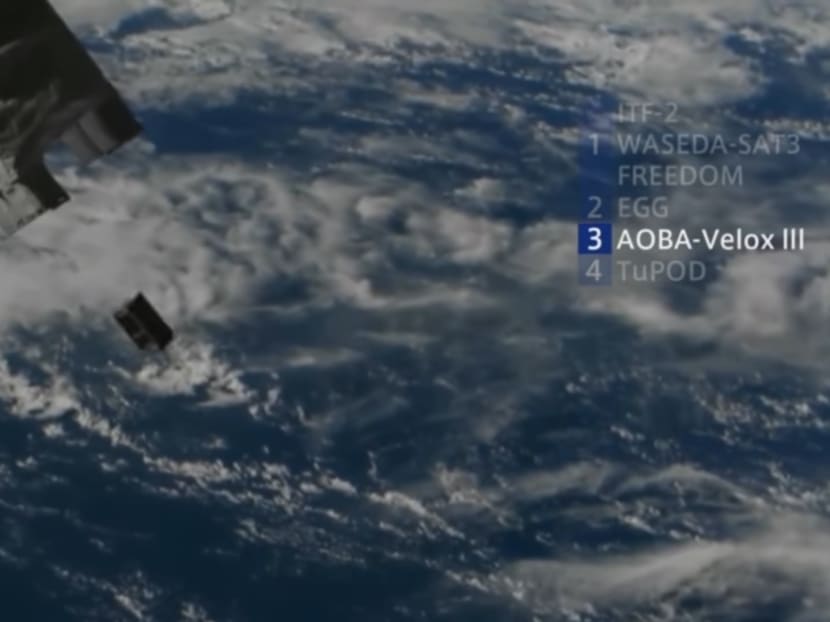NTU launches Singapore’s first satellite from International Space Station
SINGAPORE — A satellite by Nanyang Technological University (NTU) made history on Tuesday (Jan 17) by becoming the first Singapore satellite to be launched from the International Space Station (ISS).
SINGAPORE — A satellite by Nanyang Technological University (NTU) made history on Tuesday (Jan 17) by becoming the first Singapore satellite to be launched from the International Space Station (ISS).
The Aoba Velox-III is also NTU’s seventh successful satellite launched into space. It is a 2.3kg nano-satellite measuring 10cm by 10cm by 20cm, and it was shot into orbit around the Earth using a special launcher by a Japanese astronaut at the ISS, instead of being launched from a rocket.
A joint project between NTU and Japan’s Kyushu Institute of Technology (Kyutech), the satellite is now orbiting 400km above sea level and will be used to conduct several tests, including on a made-in-NTU micro-propulsion system, a new wireless communication system developed by Kyutech, and consumer-grade electronic components in space.
NTU said that new micro-thrusters installed on the satellite would help to keep it in orbit at a speed of 27,000kmh for up to six months, compared to the usual three-month flight lifespan for smaller-sized satellites.
The university said in a statement, “Traditionally, small satellites do not have thrusters due to modest budgets and insufficient space to mount the conventional thrusters used by bigger satellites. Without thrusters, satellites have no means to keep them in orbit and will gradually lose altitude.
“The nano-satellite features a unique micro-thruster built by NTU, which enables the satellite to remain in space twice as long than it usually would.”
Mr Lim Wee Seng, director of the NTU Satellite Research Centre, added that the space experiments by Aoba Velox-III would enhance the university’s satellite-building capabilities, paving the way for the next generation of nano-satellites that is more advanced and reliable.
The team is now developing a second joint satellite with Kyutech “which could lead to small and manoeuvrable satellites being used as space probes in future”, he added.
Professor Mengu Cho, director of Kyutech’s Laboratory of Spacecraft Environment Interaction Engineering, said the Aoba Velox-III is “an important milestone in Japan-Singapore inter-university space exploration”.
“We are looking forward to another joint satellite that is under development and scheduled to be launched in 2018. The long-term goal of the Kyutech-NTU joint space programme is to do a lunar mission using the technologies demonstrated by these two satellites,” he said.
Professor Yoon Soon Fatt, chair of NTU’s School of Electrical and Electronic Engineering, said, “Satellite technology is a field that requires strong expertise across several disciplines, from power systems and batteries to integrated circuits and wireless communications. The actual designing, building and operating of real satellites in space provides a huge boost to the learning journey of our students and is an unparalleled experience for those seeking careers in the space industry.”
The X-Sat, Singapore’s first locally built satellite, was first launched in April 2011. The fridge-sized micro-satellite weighing 105kg was built by NTU and DSO National Laboratories.
Among other satellites developed over the years was Velox-I, a 4.5kg nano-satellite built by students and research staff members. It featured a novel mechanism that allowed it to piggyback on the Velox-PIII, a 193g mobile-phone-sized pico-satellite.
They were sent into space as one unit, but separated in the later part of the experiment to test an inter-satellite communications system. Both were launched in June 2014 as one of five mission satellites loaded onto a space rocket owned by the Indian Space Research Organisation.
Following that, the Velox-CI — a 123kg mini-fridge-sized satellite funded by Singapore’s Economic Development Board — was designed and used to study tropical climates. It was launched in December 2015 together with four other satellites from India, as well as a 12kg nano-satellite owned and developed by Addvalue Innovation, which deals in various satellite-communication products.







